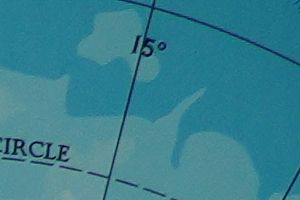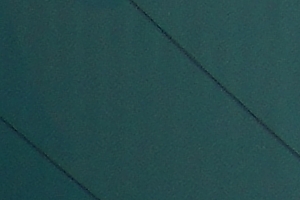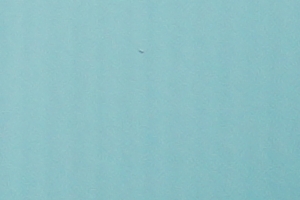Sony FE 24-105mm F/4G OSS Review
Sony FE 24-105mm F/4G OSS
One of the most anticipated FE lenses certainly was the Sony FE 24-105mm F/4G OSS. This constant-aperture standard zoom arrived in late 2017, four years after Sony introduced their first Full-Frame E-mount mirrorless. Until then, Sony had two standard zooms, both with the more common 24-70mm focal-range, while other Full-Frame systems offered longer 24-105mm or 24-120mm lenses. Both previous Sony models are discussed on the right column of this Sony FE 24-105mm F/4G OSS review.
Modern standard zoom lenses cover focal-lengths between ultra-wide and telephoto. For Full-Frame, these lenses start at 24 or 28mm and reach somewhere between 70-120mm. Even though there is only a span of 4mm between the wide-end of different standard zooms, this difference changes the angle-of-view from 84° to 75° which is significant. By pushing the long-end from 70 to 105mm, which is numerically is a much larger jump, the angle-of-view changes the same way from 34° to 23°. Again, this difference is substantial.
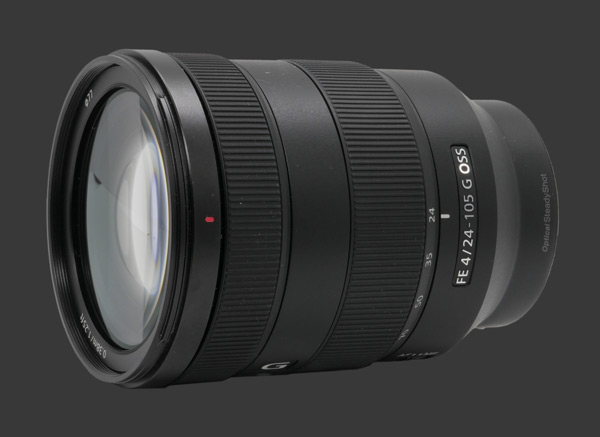
The Sony FE 24-105mm F/4G OSS is perhaps the most versatile FE lens on the market. Its focal-range spans an ultra-wide field-of-view until a short telephoto reach while maintaining a moderate F/4 maximum aperture. This lens manages an exceptionally high 0.31X magnification for close up photography. Sony even incorporated a built-in image-stabilization system in the lens for use with their earlier unstabilized mirrorless cameras.
With its broad focal-range, close minimum focusing distance and weatherproof construction, the FE 24-105mm F/4G is suitable for a huge variety of subjects. This covers extremely well all types of portraits from environmental to close ups, plus urban, travel, landscape and product photography, regardless of the weather.
An F/4 maximum aperture is neither bright nor dim. Full-Frame cameras generally excel in low-light and so this moderate aperture is sufficient for typical scenes. Towards the telephoto-end of the zoom, F/4 can even produce a relatively shallow depth-of-field that to isolate a subject from its background. Most recent Sony Full-Frame Mirrorless Digital Cameras offer between 4 and 5½-stops of image-stabilization which allows subject motion to blur nicely while the background remains sharp.
Bokeh is pleasantly rendered by a 9-blade aperture that can be stopped down to F/22 which is beyond the diffraction limit of most digital cameras. This lens can focus down to 38cm from the focal-plane. The front features a bayonet mount of a supplied petal-type hood and is threaded to accept 77mm filters.
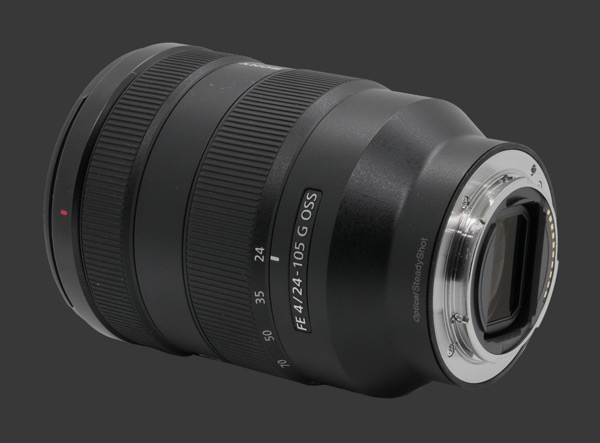
Construction
Sony built the FE 24-105mm F/4G OSS from a solid high-grade plastic. Most of this largely cylindrical lens is 84mm in diameter with a single 45° angle leading to a smaller 60mm portion which lines up with the width of the Sony E-mount. Even though it feels substantial, it is a pinch lighter and longer than comparable lenses for other Full-Frame Mirrorless platform. The FE 24-105mm does not offer any appreciable advantage other an F/4 standard zoom for SLR either. In fact, it is both longer and wider than the Nikkor AF-S 24-120 F/4G ED VR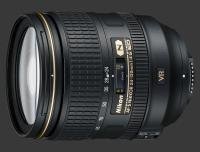
Nikkor AF-S 24-120 F/4G ED VR that offers even more reach.
This sturdy weatherproof lens weighs 663g which places it halfway between the Sony F/4 and F/2.8 lenses with a 24-70mm focal-range that weigh 426g and 886g, respectively. Where the wider portion of the cylinder starts, there are two sliding plastic switches. These switches have a firm detents to minimize accidental changes. Of all parts on this lens, these are the only two that do not feel so sturdy. The top switch selects between AF and MF mode. The lower one enables image-stabilization.
Sony unfortunately couples the stabilization switch with the camera body so it is impossible to only use one form of stabilization mechanism. This can get tedious to work with since one can disable stabilization in the camera body while using an unstabilized lens only to have it enabled when switching lenses! This is compounded by fact that there noise in the system introduces shake when shooting from a tripod.
Around halfway along the lens barrel, there is a 1"-wide zoom ring which rotates clockwise 80° from 24 to 105mm. The ring turns with a good amount of resistance which prevents any zoom creep. An unmarked round button on the lens barrel can be customized by the camera. Towards the front of the lens barrel, a slimmer fly-by-wire focus ring rotates extremely smoothly and indefinitely. It only adjusts focus in MF mode or DMF mode after autofocus locks. When the camera is unable to autofocus, it is therefore necessary change to MF mode.
The front of the FE 24-105mm F/4G has a bayonet mount to attach the included petal-type lens hood and is threaded to accept standard 77mm filters. The external zoom mechanism carries along the hood which makes it less efficient at longer focal-lengths which is true of the vast majority of zoom lens hoods.
Sony FE 24-105mm F/4G OSS Sharpness
The more zoom a lens has, the more variable its optical performance can be. Optical engineers must make compromises though and so there is frequently better sharpness in some focal-range. Within its moderate 4.5X zoom, this 24-105mm performs remarkably well but it is clearly optimized towards wide-angle.
Central sharpness is from the widest 24mm focal-length to around 50mm even completely wide-open. There is a small amount of corner softness in this focal-range which improves quickly by stopping down. Just at F/5.6, corners show more details. By F/8, images are very sharp with edges only slightly software than the center.
Around the middle of the zoom range, sharpness is very good in the center, just not quite perfect. The aperture has minimal effect on central sharpness there though but it does substantially improve corners which start quite soft at F/4. Each fractional stop leads to better corners though with very usable output from F/6.7 to F/13 when diffraction reintroduces softness on the A7R IV. With a lower resolution camera, edges look sharp from F/5.6 to F/16 when shown at 100% magnification.
The long end of the zoom delivers an exaggerated version of the performance seen in the middle of the zoom. Central sharpness is excellent wide open but corners start off very soft. They gradually improve by stopping down but corners do not reach acceptable sharpness until F/8 at 105mm. From then, sharpness increases until peaking at F/11 and F/13. They never become completely sharp but quite reasonable for moderately large prints.
Shown below are 5 crops taken from a photograph, repeatedly captured for each combination of focal-length and aperture. Smaller pieces are cropped from extreme corners of the images, while the middle wide crop is taken from the center of images. Select an aperture in a row for a desired focal-length to see the crops from the corresponding image. When judging image quality, understand that these are crops from a 61 MP image which is normally used to print images up to 45x30". On a computer display, these may appear much larger which magnifies image defects.
Performance
Distortion on this is is highly variable. Around a focal-length of 35mm, the FE 24-105mm renders straight lines perfectly. At wider focal-lengths though, there is a moderate and easily noticeable amount of barrel distortion. Straight lines curve and diverge up to 4%. Zooming in past 35mm introduces pincushion distortion which is slightly less pronounced than barrel-distortion at wide-angle, reaching 3% at 105mm. There is no doubt Sony is aware of this since, once this lens is mounted on a Sony mirrorless, the Distortion Comp item under the Lens Comp menu is greyed out and locked into Auto mode. Although it reduces the field-of-view slightly, Distortion Comp effectively limits distortion to roughly 1%.
This lens exhibits an unusually high amount of vignetting. In the extreme case, there is over 5-stops of vignetting at 24mm F/4! This improves quickly at a rate of approximately 1-stop of vignetting per stop of aperture, so F/5.6 results in 4-stops, F/8 just over 3-stops and it remains at 2½-stops from F/11 onward. Vignetting diminishes substantially when zooming in with just over 1-stop around 35mm. Longer focal-lengths reverse the trend with about 2-stops of corner shading at F/4. Stopping down at longer focal-lengths is effective with only 1-stop of vignetting starting at F/5.6 and a ½-stop by F/11.
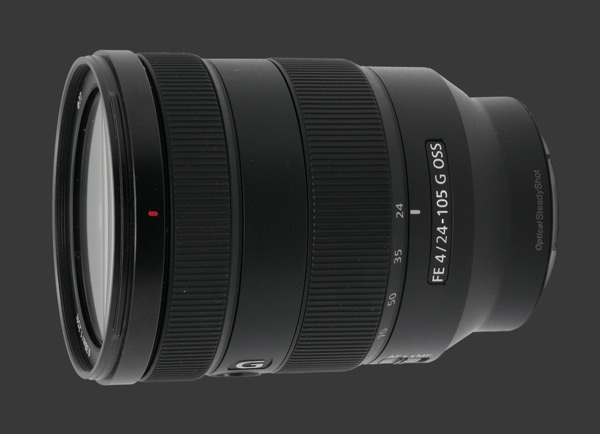
Sony camera are capable of optionally compensating for vignetting which is wise to enable for this lens. Software compensation for this optical defect is generally reliable with minimal impact on image-quality. With it enabled, the Sony A7R IV manages to keep vignetting around 1-stop at wide-angle and at a ½-stop for other focal-lengths. This is very good and hides the issue fairly well except for 24mm F/4-4.5 where slightly over one stop of shading is easily noticeable and edges show increased noise due to the significant amount of gain required to bring 5 EV down to 1¼.
Oddly there are more chromatic aberrations at 24mm where the lens is at its sharpest than at 70mm which shows slight softness. There can be aberrations along edges of high-contrast at any combination of focal-length and aperture but they are quite thin except at 24mm where fringing can exceed 2-pixels wide.
The latest lens coatings from Sony are extremely effective at preventing flaring. This Sony FE 24-105mm F/4G OSS maintains scene contrast very well even in the presence of direct light sources. The lens hood provides additional protection, mostly at wide-angle.
The autofocus performance of this lens is impressive. It locks focus decisively in an instant down to moderately low-light. Its internal focusing system advances quickly and stops very precisely which avoid back and forth movement that can be disturbing when used during video. In good light, expect autofocus to lock well below 1/4s. When light is low, autofocus naturally slows down. In dim lighting, autofocus takes around ½s and a little longer at the telephoto end of the zoom.

Conclusion
A highly versatile lens necessarily makes compromises which Sony balanced exceptionally well on the FE 24-105mm F/4G OSS. This lens proves to be quite sharp overall. Corners are problematic though and stopping down never makes them completely sharp in the longer half of the zoom. Still, it captures plenty of details for mid-sized prints to look crisp. Distortion and vignetting are obvious issues with its optical design yet are surprisingly well correct by in-camera processing. Photographers that capture RAW files though are going to spend more time to compensate for these issues though.
Autofocus is fast when there is enough light and it locks focus in a single movement. The lens appears to be very sturdy on top of being weatherproof which makes it suitable of heavy use. With coverage from ultra-wide to telephoto, the Sony FE 24-105mm F/4G OSS is an essential lens to have on a Sony Full-Frame Mirrorless Digital Camera. It really fits the general purpose zoom category better than any other current Sony E-mount lens.
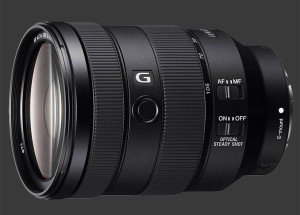
Please Support Neocamera
All information on Neocamera is provided free of charge yet running this website is a huge endeavor. Purchases made via affiliate links found throughout the site help keep it running and up-to-date. There is no additional cost to you, so please consider buying via these links to our affilates:
If you found any information on this site valuable and did not purchase via our affiliate links, please considering donating via PayPal:
Any amount will be greatly appreaciated. Thank you for your support!
Sony FE 24-70mm F/4 ZA OSS
Sony moved the E-mount to full-frame with several lenses built in collaboration with Zeiss, including the very first FE standard zoom, the Sony FE Vario-Tessar T* 24-70mm F/4 ZA OSS. This ground-breaking lens covers an ultra-wide to normal angle-of-view in a weatherproof body.
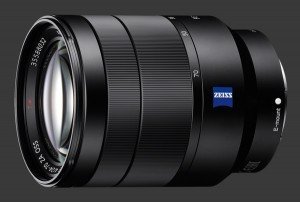
Optics manufactured by Zeiss are one of the most highly-regarded in the world and this collaboration between Sony and Zeiss exposed the Zeiss name to consumers while providing Sony with such high-quality lenses. Weighting just 426g, the Sony FE Vario-Tessar T* 24-70mm F/4 ZA OSS
Sony FE Vario-Tessar T* 24-70mm F/4 ZA OSS remains the lightest constant-aperture zoom lens for Full-Frame Mirrorless Digital Cameras ever made.
The T* in the name of this lens indicates special Zeiss lens coatings to maximize contrast and reduce flare. These coatings are used even for small lenses of viewfinders on many Sony cameras. Although Sony acquired sensor-shift stabilization technology from Konica-Minolta, which they were using on larger cameras, Sony Full-Frame Mirrorless did not offer built-in image-stabilization when the 24-70mm F/4 ZA OSS launched.
This lens is worth considering for its incredibly light weight. It is noticeably smaller and 30% lighter than the FE 24-105mm F/4G OSS. Optically this lens is reputed to be rather uneven with very good central sharpness yet quite soft corners. It also shows very strong vignetting which was not well-corrected at the time yet the newer 24-105mm vignettes much more!
Cameras changed significantly since the Sony FE Vario-Tessar T* 24-70mm F/4 ZA OSS launched. The IBIS makes its OSS unnecessary while new mirrorless use Phase-Detect AF which this lens was not designed for. Most importantly, full-frame digital camera resolution in 2013 was between 24 and 36 MP which requires a reevaluation of the performance of this lens.
Sony FE 24-70mm F/2.8GM
On the high-end of standard zoom scale, Sony released the FE 24-70mm F/2.8 GM a year before the FE 24-105mm F/4G OSS. Part of their premium G-Master series, this lens is built for the newest Sony mirrorless bodies.
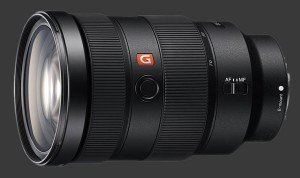
This zoom lens is part of the F/2.8 trinity, three lenses that together span a focal-range of 12-200mm with a maximum F/2.8 aperture throughout the entire range. This makes the Sony FE 24-70mm F/2.8 GM a full-stop brighter than the 24-105mm F/4G. In exchange for having brighter optics, the F/2.8 GM concedes a sizable focal-range.
The Sony FE 24-70mm F/2.8 GM
Sony FE 24-70mm F/2.8 GM is built to the highest optical performance which comes with substantial weight. At 886g, this lens is 30% heavier than the 24-105mm F/4G. Its optics have slightly lower magnification too. There is no need for stabilization either which allows more precise positioning of optical elements and fewer moving parts that translates into an even more durable weatheproof construction.
Without a doubt, the Sony FE 24-70mm F/2.8 GM is an excellent lens with better performance than the FE 24-105mm F/4G OSS. It is, however, both heavier and significantly more expensive. Due to the weight difference, the 24-105mm F/4G better helps realize the size-advantage of a mirrorless system.
Updates
2024.11.18

Best 2024 Photography Gifts for Every Budget
Great gifts for photographers and photo enthusiasts selected for every budget among the best products of 2024.
2024.08.07

Eye Protection Tips for Professional Photographers
The four main considerations for professional photographers regarding eyewear.
2024.07.14

Fujifilm X100VI Review
Flagship fixed-lens compact digital camera with a 40 MP sensor and Image-Stabilization, a first for the series. Retro design featuring dual control-dials, plus direct ISO, Shutter-Speed and EC dials. Its hybrid viewfinder can switch between EVF and OVF mode.
2024.05.09

Fujifilm GFX100 II Review
Flagship 102 Megapixels Medium-Format Mirrorless Digital Camera with 8-Stop 5-Axis IBIS, 8 FPS Drive, 8K Video and 400 MP Super-Resolution capture in a weatherproof and freezeproof body with dual control-dials and dual memory-card slots.
2024.04.03

Fujifilm X-T5 Review
Newest Fujifilm flagship boasting a 40 MP APS-C sensor, 5-axis IBIS with 7-stop efficiency, 15 FPS continuous drive, 6.2K Video capture, dual control-dials and dual SDXC UHS-II slots in a sturdy weatherproof and freezeproof body.
2023.11.20

Best Digital Cameras of 2023
Find out which are the Best Digital Cameras of 2023. All the new Mirrorless Digital Cameras from entry-level to high-end professional.
2023.07.10

Fujifilm X-H2 Review
40 Megapixels APS-C Hybrid Mirrorless Digital Camera with 7-stop IBIS. Fastest shutter ever and 8K video capture. Large builtin EVF with 0.8X magnification and 5.8 MP, plus an Eye-Start Sensor. Packed with features and large number of controls in a weatherproof and freezeproof body.
2023.05.07

Sony FE 20-70mm F/4G Review
Review of the unique Sony FE 20-70mm F/4G lens. The optical zoom of this lens spans ultra-wide-angle and medium focal-length coverage, making it one of the most versatile Full-Frame lenses on the market.
2023.01.15

Huion Inspiroy Dial 2 Review
Review of the Huion Inspiroy Dial 2 tablet, a medium sized drawing surface with dual dials and customizable buttons. Connects via USB-C or Bluetooth 5.0 with Windows, Linux and Android support.
2022.12.08

How to Pack for a Photo Trip
Find out how to pack for a travel photography trip, carry your gear safely while meeting airline regulations.
2022.11.13

Best Digital Cameras of 2022
The best digital cameras of 2022. A short list of the most outstanding models in their respective categories. Choose one for yourself or as a gift.
2022.09.21

Pentax DA* 60-250mm F/4 SDM Review
Review of the Pentax DA* 60-250mm F/4 SDM, the constant-aperture telephoto zoom with the highest zoom-ratio on the market.
2024.11.18
2024.08.07
2024.07.14
2024.05.09
2024.04.03
2023.11.20
2023.07.10
2023.05.07
2023.01.15
2022.12.08
2022.11.13
2022.09.21
NEWS
2024.12.17

Venus Unveils 2 Tilt-Shift Macro Lenses
Lens
2024.12.17

Panasonic Lumix G97 and ZS99 Launched
Digital Camera
2024.11.19

Sony Unveils Their Brightest Zoom Lens
Lens
2024.11.19

Sony Finally Upgrades Alpha A1 Flagship Camera
Digital Camera
2024.11.12

New Laowa Slim Ultra-Wide Lens
Lens
2024.11.07

Hasselblad Adds XCD 75mm Lens
Lens
2024.11.07

Nikon Launches Z50 II
Digital Camera
2024.11.05

Venus Created Worlds First Shift Zoom Lens
Lens
2024.11.01

Nikon Announces Development of Standard Power-Zoom Lens
Lens
2024.10.30

Canon Launches 3D APS-C plus 3 Extra RF Lenses
Lens
2024.10.14

Fujifilm Extends APS-C Lineup
Digital Camera ○ Lens
2024.09.27

Leica Launches New Q3 with 43mm Lens
Digital Camera









